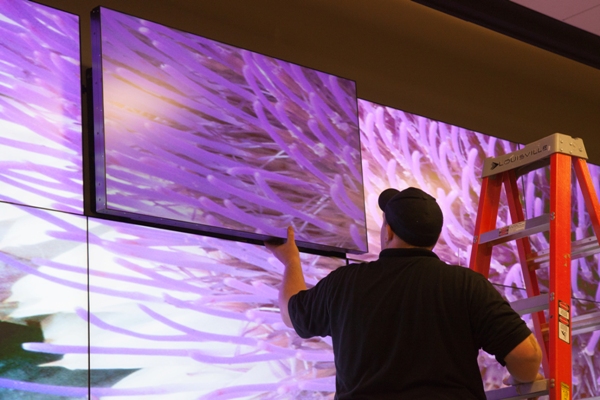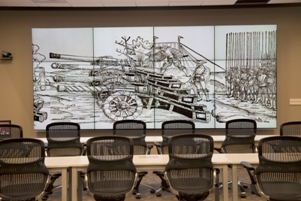 The Brown University Library this month opened its new Patrick Ma Digital Scholarship Lab, a facility that offers students access to software used by a variety of disciplines in a state-of-the-art viewing and listening environment. The centerpiece of the lab is a video visualization wall made from twelve 55-inch LED screens, which can be used together to show a single seven foot by 16 foot image or video at 24 megapixel resolution, or linked to individual touch-screen monitors for groups or classes working on collaborative projects. The wall is also set up for videoconferencing, which will facilitate events such as group meetings and long-distance lectures.
The Brown University Library this month opened its new Patrick Ma Digital Scholarship Lab, a facility that offers students access to software used by a variety of disciplines in a state-of-the-art viewing and listening environment. The centerpiece of the lab is a video visualization wall made from twelve 55-inch LED screens, which can be used together to show a single seven foot by 16 foot image or video at 24 megapixel resolution, or linked to individual touch-screen monitors for groups or classes working on collaborative projects. The wall is also set up for videoconferencing, which will facilitate events such as group meetings and long-distance lectures.
The role of the academic library has always involved providing students and faculty with the resources and tools they need to interact with various forms of recorded knowledge, said University Librarian Harriette Hemmasi. But “the format and scope have changed considerably. We have many new, evolving technologies, and libraries are very keen to be part of this environment, because we believe this is where our future is—to work with new technologies and new methodologies in scholarship, research, teaching, and learning.”
 The visualization video wall offers a combination of size and resolution that wouldn’t be possible with a projector, allowing students to view highly detailed images in a classroom setting. And since individuals can also control portions of the wall, it opens up unique new possibilities for both lectures and group projects.
The visualization video wall offers a combination of size and resolution that wouldn’t be possible with a projector, allowing students to view highly detailed images in a classroom setting. And since individuals can also control portions of the wall, it opens up unique new possibilities for both lectures and group projects.
“There are different modes of collaboration,” explained Patrick Rashleigh, the library’s new data visualization coordinator, who will oversee the lab. “You can have a large group of people looking at the same visual artifact on screen, or you can have multiple people displaying their own artifact, and everyone being able to see others’ work. And then variations in between those two extremes.”
The ability for students to display not only images that they’ve collected, but data and text that will be easily viewable by the rest of a group will make the lab “a very enriching kind of space,” Hemmasi added.
Panoramic view
Inspiration for the visualization video wall came, in part, from the unlikeliest of sources—a 19th century watercolor panorama chronicling the achievements of Italian general Giuseppe Garibaldi, which had been donated to the university’s Anne S. K. Brown Military Collection in 2005.
Displaying a relatively delicate work of art that is four and a half feet tall, more than 270 feet long, and painted on both sides can pose a few challenges, to say the least. But when Brown’s Department of Italian Studies found out about the painting during a symposium on Garibaldi organized by Professor Massimo Riva, they were eager to have access, according to the Brown Daily Herald. In 2007, the Library’s Center for Digital Scholarship digitized the entire panorama using funding from the department and a donor.
The library later acquired a Microsoft Surface (now known as PixelSense) with a 30-inch, tabletop interactive touch screen. This proved to be an excellent hardware resource when one or two people wanted to interact with digitized projects like the Garibaldi panorama. But it was too small for groups or classes to use.
“We were able to connect the Surface [computer] to a large screen that was a slave screen or dummy screen,” Hemmasi recalls. “That gave us the idea that we really need a place where we can work individually but also work in groups…This was kind of the genesis of the idea for a digital scholarship lab—a place where people could talk to each other, but machines could also talk to each other.”
 Last summer, while putting together a request for proposal for equipment that would be used in the lab, Hemmasi interviewed “about a dozen” faculty members from various fields to find out what type of software they were using and what type of needs they might have within this type of lab environment. Brown already had a CAVE 3D immersive environment lab, she noted, but it requires specialized setup and programming. By contrast, the Digital Scholarship Lab was envisioned as a place that would be useful to various disciplines, ranging from the humanities to biomedical science, where students and faculty could drop by and easily figure out how to use the system, Hemmasi said.
Last summer, while putting together a request for proposal for equipment that would be used in the lab, Hemmasi interviewed “about a dozen” faculty members from various fields to find out what type of software they were using and what type of needs they might have within this type of lab environment. Brown already had a CAVE 3D immersive environment lab, she noted, but it requires specialized setup and programming. By contrast, the Digital Scholarship Lab was envisioned as a place that would be useful to various disciplines, ranging from the humanities to biomedical science, where students and faculty could drop by and easily figure out how to use the system, Hemmasi said.
“That’s the reason we chose the kind of wall that we’re installing, believing that it is more stable, more user friendly, and frankly can be used with different kinds of software,” Hemmasi explained.


